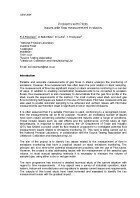Air Monitoring
Problems with Pitots. Issues with flow measurement in stacks.
Oct 06 2014
Author: R A Robinson, D Butterfield, D Curtis, T Thompson on behalf of CEM

Free to read
Articles are free to download. Please login to read this article or create an account.
Introduction
Reliable and accurate measurements of gas flows in stacks underpin the monitoring of emissions. However, flow measurement has often been the poor relation in stack sampling. The measurement of flow has significant impact on stack emissions monitoring in a number of ways. In addition to enabling concentration measurements to be converted to emission fluxes, flow measurement is also necessary to demonstrate that the gas flow profile in the stack meets the requirements of the method. The most routinely used stack and duct gas flow monitoring techniques are based on the use of Pitot tubes. Pitot tube measurements are also used to enable isokinetic sampling to be achieved and verified. Issues with Pitot tube measurements can therefore result in significant errors in reported emissions.
It is often assumed that if a suitable Pitot tube is used, conforming to a recognised model, then the measurements will be fit for purpose. However, an increasing number of issues have been raised concerning potential measurement failures under a range of conditions. These include issues such as wall effects and the performance of Pitot tubes at high temperatures. In response to these concerns, the UK Department of Trade and Industry (DTI) has funded a project under its flow research programme to investigate potential flow measurement issues related to emissions monitoring [1]. This work is being carried out by the National Physical Laboratory, in collaboration with the Source Testing Association and Littlebrook Calibration and Manufacturing Ltd.
The aim of the project is to identify key issues related to the measurement of flow in emissions monitoring that have a practical impact on stack emissions monitoring. The principle aim is to review the potential measurement problems with the use of Pitot tubes. However, the project is also addressing issues with the measurement of the sampled gas volume. In most manual sampling methods it is necessary to measure the volume of sampled gas, using either a dry or wet gas meter.
The work programme has involved a detailed technical study of the current situation with regard to flow measurements. A key aspect was a survey of industrial operators, stack testers, instrument manufacturers and regulators to assess current issues and requirements. The outputs of this broad study have been reviewed and assessed to identify the key measurement areas with the greatest impact.
Digital Edition
AET 28.2 April/May 2024
May 2024
Business News - Teledyne Marine expands with the acquisition of Valeport - Signal partners with gas analysis experts in Korea Air Monitoring - Continuous Fine Particulate Emission Monitor...
View all digital editions
Events
Jul 30 2024 Jakarta, Indonesia
China Energy Summit & Exhibition
Jul 31 2024 Beijing, China
2024 Beijing International Coal & Mining Exhibition
Aug 07 2024 Beijing, China
IWA World Water Congress & Exhibition
Aug 11 2024 Toronto, Canada
Aug 25 2024 Stockholm, Sweden and online





.jpg)








